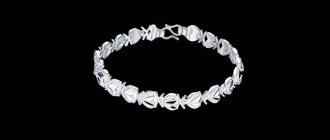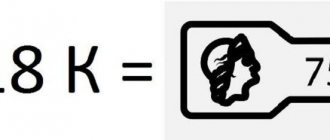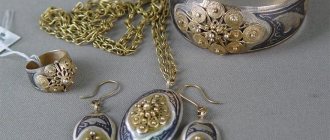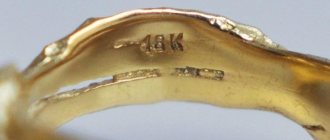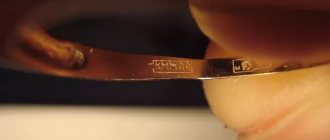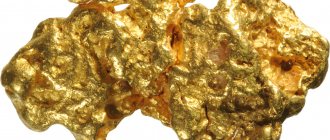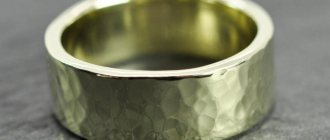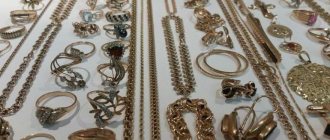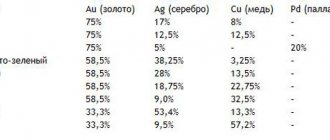What types of gold are there?
In Russia, precious metals presented on store shelves must be labeled. There are only 7 gold hallmarks. At present, some of them are outdated:
- 375. Precious metal content 37.5%. The rest is a ligature (admixture).
- 500. Contains 50% pure gold. It is rare nowadays.
- 583. Precious metal content 58.3%.
- 585. 58.5% precious metal. This includes 80% of jewelry sold.
- 750. Contains at least 75% pure gold. Widely distributed among exclusive jewelry and diamond jewelry.
- 958. 95.8% precious metal. A small number of such jewelry were produced in past centuries.
- 999. Pure gold. The metal is too soft, so it is not used in jewelry.
As you can see, 925 is not among them.
Another legend
Sometimes it is mistakenly believed that 925 gold is the so-called white gold. This term also requires more careful study. The white color of jewelry comes from palladium coating, as well as the inclusion of the same palladium in the alloy. When developing such a composition at the beginning of the last century, nickel and manganese were also used, but subsequent studies proved that nickel is unsafe for humans, and manganese does not give the desired effect. It is interesting that, unlike most jewelry alloys, in this case the price of the additive (palladium) is significantly higher than that of the base metal. The legend that such a metal has 925 fineness most likely arose from a combination of the appearance of white gold and the markings of silver, which is visually similar to it.
Thus, 925 gold does not exist, either in production or in everyday life, and in the conversations of people who are not very familiar with jewelry, this term usually refers to high-quality silver or a gold alloy that has a white color due to the inclusion of palladium in it.
How to distinguish silver and white gold?
It is difficult to understand with the naked eye how silver differs from white gold. Reading the labels will help. New items - both silver and gold - can be the same color due to the finishing treatment - rhodium plating. Platinum group metal is applied to enhance shine and protect against darkening.
If there are no markings, you can check the quality of the metal at a pawnshop or workshop. The employee will conduct a rapid analysis using:
- Reagents. To check, you will need to file the product a little so that a fresh cut appears, onto which the reagent is applied. There should be no reaction when testing gold. If it passes, it means that the metal does not correspond to the declared standard. When checking silver, the cut area will acquire a reddish-brown tint. If this is not the case, it means that this is a product made from a different alloy.
- Touchstone. Alloys of precious metals are tested using individual rocks. The product is rubbed on the touchstone. If the trace left does not meet established standards, then the alloy contains a lower percentage of pure metal than stated.
- Electronic analyzer. Some stores, workshops or pawn shops have equipment that determines the exact percentage of precious metal content in the alloy. Rarely seen.
At home you can perform the following check:
- Paper. Draw metal along the sheet. Gold jewelry will not leave a mark, silver (even high, 925) should leave a dark stripe behind it.
- Acid. Pour a spoonful of vinegar into a glass of water and stir. After this, place the item being tested into the solution. If you have silver in front of you, the water will change color and become dark. The product itself will oxidize. This will not happen with gold: it is not afraid of an acidic environment.
- Iodine can be used to draw a stripe on an object. There will be no mark left on gold jewelry. If it is silver, the product will become stained and it will be difficult to remove the iodine.
Application
It is known that the most popular gold alloy among jewelers and buyers is the one with 585 purity. As for silver, 925 is considered the highest quality metal. Silver, like gold, is not used in the production of jewelry in its pure form, and all because such a metal is too plastic, and therefore short-lived. Therefore, in order to enhance its strength, an alloy is also added to silver - impurities of non-ferrous metals: germanium, titanium, zinc, platinum, bromine and silicon. 925 silver looks quite elegant, which explains the popularity of products made from this metal. In addition, high-grade silver goes perfectly with gold, so in many jewelry you can find a harmonious combination of these two metals.
925 silver is traditionally called sterling silver, since sterling was minted from this metal in Great Britain.
In jewelry stores you can often find gold-plated jewelry made from 925 silver. The gold layer in the manufacture of such jewelry is applied by electroplating. The average person assessing the appearance of gilded silver is unlikely to be able to distinguish it from gold. This explains the popularity of gold-plated silver products:
- they look like gold;
- they have a lower cost per gram.
High-grade silver goes well with precious stones - diamonds, topaz and others. Products made from this metal look truly graceful and elegant. Cutlery - spoons - are also made from 925 sterling silver. The only disadvantage of silver is its low estimated value when delivered to a pawnshop.
925 sterling silver rings
Characteristics of 925 standard
The alloy contains several elements responsible for color and strength. This material is much harder than its counterparts.
Composition and properties
The 925 item is only 92.5% pure silver, the remaining 7.5% is copper. It is added to give the alloy greater strength. Thanks to impurities, even gold alloys become white and very similar to pure silver.
Allergy to nickel contained in the composition is common to many. Manifests itself in the form of dermatitis. Since 2000, the use of nickel in alloys has been prohibited in the European Union.
Strength
925 silver is durable and easy to process. Items made from this metal are less scratched. The alloy is practical and less likely to deform.
Castas (seats for the stone) in white alloys are made so that its krapana (legs that hold the stone) do not unbend and the inserts do not fall out, which is a common problem in products made from red and yellow materials.
Brand
The mark is responsible for who made the jewelry and in what year. The manufacturer applies a name at the final stage of production, after which it is handed over to the Assay Office, where the quality of the metal and the content of the required amount of pure silver are checked. If the percentage of content meets the standard, a sample is applied to the jewelry, for example 925.
Application
The strength of the alloy allows it to be used for the manufacture of watch parts and jewelry (bracelets, key rings).
Gold or not?
Every person who sees a piece of jewelry with a hallmark of 925 should know that he is not dealing with gold, since the alloy of this metal cannot have such a hallmark.
925 silver ring
In the Russian Federation and other post-Soviet countries, the 925 standard exists only for silver, including gold-plated silver. This confuses many people: for example, a buyer comes to a jewelry store and sees on the display a piece of jewelry that looks like gold and has a 925 standard. In this case, we will be talking about gilded silver jewelry. In addition, when evaluating a product and issuing a stamp with hallmarks, gilding is not taken into account. The price per gram of such a product will correspond to the price of a gram of silver. Therefore, the question of whether 925 is gold or silver has only one answer: this characteristic is valid only for silver.
Tips for choosing jewelry of this sample
When choosing jewelry, you should pay attention to the presence of markings. All precious goods on store shelves must have manufacturer's tags with contact information and a retail chain price tag.
Expert opinion
Vsevolod Kozlovsky
6 years in jewelry making. Knows everything about samples and can identify a fake in 12 seconds
Please note the absence of piercing elements in the design of the model. The decoration should be comfortable and light. It is advisable that the stone (or path of stones) is not raised too high.
If the product contains diamonds over 4 mm in diameter, see if there is a certificate for the stone.
958th
Nine hundred fifty-eighth consists of 95.8% base metal and the remaining percentage alloy. Depending on the alloy content, the color varies from light yellow to deep orange. It is 23 carats.
Unpopular in Russia, appreciated in eastern countries. Used for massive jewelry rings, like gold leaf, in the food industry (gold decorations for cakes and pastries), as part of pendants, pendants, earrings, and bracelets.
Advantages:
● does not cause allergies, itching, redness due to the pure alloy;
● does not leave spots or streaks on the skin;
● does not oxidize;
● does not corrode;
● investments.
Flaws:
● low level of strength - products made from 958 are not worn every day;
● fragility - quickly lose their presentation, become covered with scratches, dents, chips;
● careful care is required - avoid contact with aggressive media, have them cleaned by professionals;
● special storage conditions are required - in sealed boxes or soft bags, in the absence of direct sunlight, each product is stored separately.
Reviews
Victoria, 32 years old: “For me personally, the main difference between silver and white gold is color. The silver is much lighter, the models are ordinary, almost unremarkable. White gold jewelry is dark, bright, and almost always encrusted with diamonds or semi-precious stones.”
Tatyana, 20 years old: “My beloved gave me a ring with a stone, I thought for a long time what kind of metal it was, until I took a magnifying glass and examined “925.” It turned out to be silver..."
Anna, 36 years old: “I don’t understand how to distinguish white gold from silver. As for me, they are exactly the same metals. And is it worth overpaying?
Svetlana, 28 years old: “I adore white gold, but only in its original color without any coatings. A little yellow looks natural and does not require additions. Silver is not for everybody.”
How is vermeil jewelry made?
Vermeil, or simply silver plated, is a term used to refer to jewelry or other items made from silver and plated with gold. The word "vermeil" comes from the French and is pronounced "ver-may".
An alternative term is "silver gilt", which has the same meaning as "vermeil".
Gold-plated items are made by first creating a base of silver, which is then coated with a thin layer of gold.
The method used to apply gold to the surface of a product is called electrolysis.
Gold plating can be of varying degrees of purity, but in the United States there is a minimum requirement: to be considered gold plating, the gold plating must be at least 10 karats (equivalent to approximately 42% gold content).
What determines the color of the sample?
Pure gold has a yellow color. Other shades are obtained by changing the ratio of metals in the alloy. For example, silver gives the alloy a green color, copper - a red tint, nickel, platinum and zinc - white. There are lemon, pink, orange, black and even purple alloys. They are obtained by changing the ratio of additional metals.
High quality varieties are only yellow in color, because... the proportion of the ligature is so small that it cannot affect the shade.
What is the difference between white, yellow and red gold?
The main colors of gold jewelry are yellow, white and red. The shade of the alloy is not related to the grade. For example, a ring with the mark 585 can be of any color. The changes concern only the ligature:
| Yellow | Red | White | |
| Gold | 585 | 585 | 585 |
| Silver | 187,5 | 80 | 225 |
| Copper | 227,5 | 335 | |
| Nickel | 165 |
To obtain a white tint, in addition to nickel, platinum and zinc are used.
Different colored alloys of the same grade have the same quality. However, the components of white gold - zinc and nickel - often cause allergic reactions. Jewelry with platinum is harmless and has a higher value than jewelry of other colors.
Blue, green and gray gold - truth or myth?
The high interest in gold jewelry of unusual shades has pushed jewelers to new experiments. With the help of various impurities, blue, light blue, gray, and black alloys are obtained. Sometimes yellow metal is coated with colored enamel, this simplifies and reduces the cost of obtaining a different color. However, such jewelry is short-lived and quickly becomes covered with scuffs and scratches.
Alchemists in the Middle Ages made blue gold by mixing the precious metal with iron. Modern experiments have shown that this alloy quickly rusts and turns brown.
Now blue and dark blue gold is made using iridium, gallium, and indium. This shade is also obtained using rhodium plating. Casting blue alloy is a labor-intensive and complex process and is more fragile than traditional jewelry. To obtain a gray color, jewelers mix pure precious metal with nickel and manganese.
A large amount of silver gives the metal a green tint. This alloy was found in the form of nuggets. Another name for this material is electrum. The first mentions of it date back to the 3rd millennium BC. Modern jewelers achieve a variety of shades from rich green to olive.
